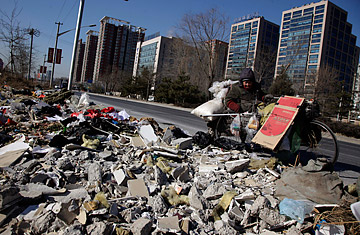
A man scavenges for resalable materials among garbage accumulated along a road in Beijing on Jan. 20, 2011

This post is in partnership with Worldcrunch, a new global-news site that translates stories of note in foreign languages into English. The article below was originally published in the Economic Observer.
China's capital has grown so huge that it now has seven peripheral roads. It is also becoming encircled by garbage. This is both a poignant metaphor and serious dilemma. Wang Jiuliang, a photographer, was the first to expose the city's little-known Seventh Ring Zone garbage dumps in his documentary video and photos entitled Besieged by Garbage. Wang illustrates the scope of the problem by marking the 400 sites in yellow on a Google map, forming a dense ring, effectively encircling Beijing. The image is shocking, of a city besieged.Wang has visited all 400 refuse heaps. "When you walk around these landfills, you can hear the sound of money flowing everywhere. Behind each dumping site lies interests," he says, his voice charged with emotion.
I went to one of these dumping grounds near Xiaozhangwan village, 3 km south of Beijing's Sixth Ring Road. Scavengers were separating cloth, metal and plastic out of the garbage, then putting the remaining waste into a more distant pit.
According to villagers, the pit with an area of about 300 acres, was formerly a sandpit around 6 to 7 m deep. It has been contracted to private individuals since 2009, and is now almost completely full. A thin layer of earth covers the pit. Above it are lines of shanties for those who work on the site.
The illegal dump is not within Beijing's sanitary-monitoring system. Contractors have simply paid the village to operate their garbage-recycling business. I headed west from Xiaozhangwan village for 2 km and found, sheltered behind a forest, another bigger refuse dump housing much of the same activity.
Charged by the Truckload
Unrecoverable rubbish like mud, human waste, building rubble and domestic waste is dumped directly into the pit. The charge for dumping depends on the size of the truckload. As for recyclable materials, the site is divided into sections for timber, metal, domestic junk and so on.
One of the subcontractors, from Xinyang in Henan province, said he moved here from another dump last year, and that most of the people working here were his compatriots from Xinyang. "The operators are all local people. They rent the pits from their village and then subcontract them to us," he told me.
Wang encountered serious trouble while making his documentary film. Some people chased him with knives or dogs. Others would warn him: "You are looking for trouble." He was once encircled by a dozen young men who threatened to break his camera. Finally they let him go after deleting the images he had taken.
After the release of his documentary, Wang revisited the dumping sites he had seen. Fifty percent of them had been dealt with by the city government. Some had been cleaned up, only for people to restart the dumping. Thirty percent of them are not yet dealt with.
